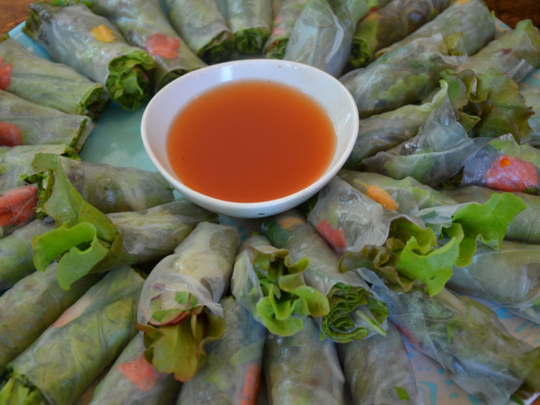
A cook needs a collection of multi-vegetable recipes that celebrate whatever’s in the garden. An omelette, a stir-fry, a pot of minestrone — all of these dishes take their cue from what’s at hand.
One of my favourites is the spring roll — not the deep-fried type, but the kind where a piece of edible paper made from rice and/or tapioca is wrapped around fresh, raw ingredients, then dipped by diners in a savoury sauce.
Spring rolls don’t have to be made in the spring — in fact, they are often called summer rolls — but spring is the season when young lettuce leaves are succulent and hot weather has not yet given arugula and mustard greens too fierce a bite. Baby bok choy and tatsoi — any tender Asian greens, really — would be fine additions. So would baby spinach or claytonia, with its succulent little leaves.
The rolls are easy. The wrappers are usually round, translucent disks that come stacked in a plastic bag and are nonperishable, so you can keep a good supply around. When you take one out, it’s stiff and brittle, so moisten it before adding the filling. Most modern brands don’t need to be soaked but merely swiped quickly under lukewarm water from the tap. Placed one at a time on a smooth countertop or flat ceramic plate, they will soften as you arrange your filling.
If you have all of the items ready, this can be done quickly. I make a line that more or less fills the bottom third of the circle, striking a balance between soft greens and crunchier vegetables such as carrots and radishes. Herbs are important for flavour, so in the spring I’m eager for the chives to come up, followed by volunteer cilantro, shiso and dill.
I roll the wrapper from the bottom up, like a cigar, tucking everything in. My neighbour Mia Kanazawa, who makes and sells these rolls at local farmers markets, does it perfectly with her nimble fingers. Mine look a little funkier. But the moist wrapper adheres to itself as you roll, so it’s not apt to fall apart. Some people fold over the ends, but I like to see the greens poking out a bit. I cut my rolls into thirds so they’re roughly bite-size and easy to handle and don’t have to be double-dipped.
Come summer, there’s plenty of basil, mint, scallions and tender young leaves of Swiss chard. For crunchies, there’s peppers, celery and cucumbers, all cut in thin strips. Mia makes her rolls with bright nasturtium blossoms, placed so you can see them through the wrapping, and they are the best festive beginning to a summer party.
In the fall and winter, along with cold-weather greens such as kale, you might tuck in some thinly cut baby turnips, kohlrabi, savoy cabbage and whatever herbs you’ve been able to coax along on the windowsill. You can also add avocado and cooked ingredients such as shrimp.
The dipping sauce you use is very much a matter of taste. Mia makes a mysteriously delicious thin red sauce from plums she grows and preserves herself, with ginger. I’m also fond of my sister Eloise’s peanut sauce, made with peanut butter, garlic, lemon or lime juice, toasted sesame oil, soy sauce and a little bit of brown sugar. But I keep it thin. It shouldn’t be viscous and gloppy.
I can’t think of a better way to get a family to eat vegetables than these rolls — light, healthy and delicious, whatever the season.












